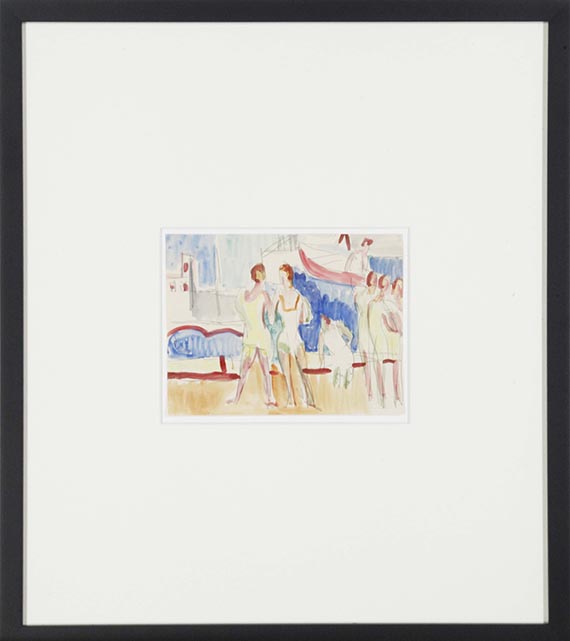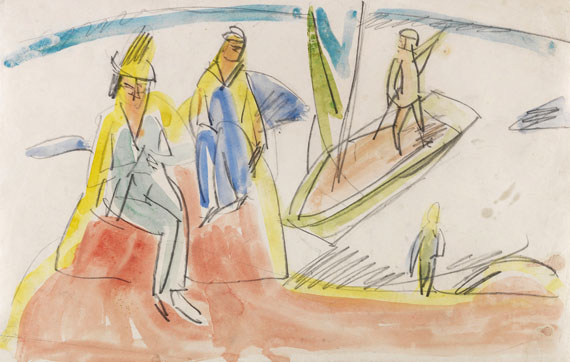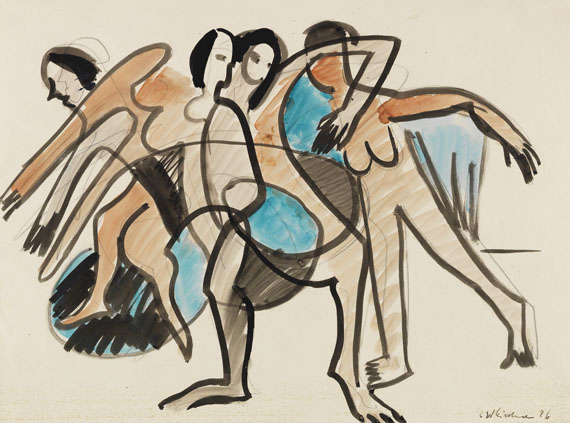428
Ernst Ludwig Kirchner
Sportler im Segelhafen, Um 1928.
WatercolorWatercolor and pencil
Estimation: € 15,000 / $ 16,050
Sportler im Segelhafen. Um 1928.
WatercolorWatercolor and pencil.
With the estate stamp of the Kunstmuseums Basel (Lugt 1570 b) and the hand-written registration number "St. 157" on the reverse. On wove paper. 16 x 20.8 cm (6.2 x 8.1 in), the full sheet. [CH].
• Elaborate watercolorfrom the Davos days.
• The closely related painting "Ruderer" (Gordon 916) was created around the same time.
• Even during Kirchner's time in Dresden and Berlin, human physiognomy, posture and a wide variety of motion sequences were at the heart of his work.
• In addition to his great fascination with dance, the pictorial motif of other sporting activities plays a major role in Kirchner's oeuvre.
This work is documented in the Ernst Ludwig Kirchner Archive, Wichtrach/Bern.
PROVENANCE: Artist's estate (Davos 1938, Kunstmuseum Basel 1946).
Galerie Wolfgang Ketterer, Munich (1968).
Hermann Gerlinger Collection, Würzburg (with the collector's stamp Lugt 6032).
EXHIBITION: Schleswig-Holsteinisches Landesmuseum, Schloss Gottorf, Schleswig (permanent loan from the Hermann Gerlinger Collection, 1995-2001).
Kunstmuseum Moritzburg, Halle an der Saale (permanent loan from the Hermann Gerlinger Collection, 2001-2017).
Buchheim Museum, Bernried (permanent loan from the Hermann Gerlinger Collection, 2017-2022).
LITERATURE: Galerie Wolfgang Ketterer, inventory catalog no. 45, Munich 1968, no. 938 (black-and-white illu.).
Galerie Wolfgang Ketterer, inventory catalog no. 51, Munich 1968/69, cat. no. 1325 (black-and-white illu).
Heinz Spielmann (ed.), Die Maler der Brücke. Sammlung Hermann Gerlinger, Stuttgart 1995, p. 279, SHG no. 410 (illu.).
Hermann Gerlinger, Katja Schneider (eds.), Die Maler der Brücke. Inventory catalog Hermann Gerlinger Collection, Halle (Saale) 2005, p. 360, SHG no. 800 (illu.).
Called up: June 8, 2024 - ca. 17.37 h +/- 20 min.
WatercolorWatercolor and pencil.
With the estate stamp of the Kunstmuseums Basel (Lugt 1570 b) and the hand-written registration number "St. 157" on the reverse. On wove paper. 16 x 20.8 cm (6.2 x 8.1 in), the full sheet. [CH].
• Elaborate watercolorfrom the Davos days.
• The closely related painting "Ruderer" (Gordon 916) was created around the same time.
• Even during Kirchner's time in Dresden and Berlin, human physiognomy, posture and a wide variety of motion sequences were at the heart of his work.
• In addition to his great fascination with dance, the pictorial motif of other sporting activities plays a major role in Kirchner's oeuvre.
This work is documented in the Ernst Ludwig Kirchner Archive, Wichtrach/Bern.
PROVENANCE: Artist's estate (Davos 1938, Kunstmuseum Basel 1946).
Galerie Wolfgang Ketterer, Munich (1968).
Hermann Gerlinger Collection, Würzburg (with the collector's stamp Lugt 6032).
EXHIBITION: Schleswig-Holsteinisches Landesmuseum, Schloss Gottorf, Schleswig (permanent loan from the Hermann Gerlinger Collection, 1995-2001).
Kunstmuseum Moritzburg, Halle an der Saale (permanent loan from the Hermann Gerlinger Collection, 2001-2017).
Buchheim Museum, Bernried (permanent loan from the Hermann Gerlinger Collection, 2017-2022).
LITERATURE: Galerie Wolfgang Ketterer, inventory catalog no. 45, Munich 1968, no. 938 (black-and-white illu.).
Galerie Wolfgang Ketterer, inventory catalog no. 51, Munich 1968/69, cat. no. 1325 (black-and-white illu).
Heinz Spielmann (ed.), Die Maler der Brücke. Sammlung Hermann Gerlinger, Stuttgart 1995, p. 279, SHG no. 410 (illu.).
Hermann Gerlinger, Katja Schneider (eds.), Die Maler der Brücke. Inventory catalog Hermann Gerlinger Collection, Halle (Saale) 2005, p. 360, SHG no. 800 (illu.).
Called up: June 8, 2024 - ca. 17.37 h +/- 20 min.
Even during Kirchner's time in Dresden and Berlin, human physiognomy, posture and a wide variety of movements were at the heart of his work. With great observational skills, the artist captured the anatomy and fleeting or complex movements of his models in just a few dynamic lines on paper, canvas and printing blocks. Throughout his life, Kirchner had an enormous fascination for dance, but the artist also pursued his early interest in movement and the human body by depicting other sporting activities. Kirchner's motifs include archery, equestrian sports, motorcycling and ski jumping (Kirchner Museum, Davos), racing and cycling (Städel Museum, Frankfurt am Main), ice skating (Hessisches Landesmuseum, Darmstadt), ice hockey (Staatsgalerie Stuttgart), acrobats on the trapeze, broad-shouldered wrestlers (Cleveland Museum of Art, etc.) and rowers.
The present watercolor from the late 1920s already shows a similar, albeit independent composition as the painting "Ruderer" (1928/29, Gordon 916), which was created at almost the same time. The male figures placed in front of a river landscape with a bridge wear sportswear typical of rowers, however, they are arranged in different groups as in the painting. The boat occupied by only one person, which will eventually fill the entire upper half of the pictorial surface in the painting, and an athlete with a stooped posture who is about to take up his oar, are already clearly worked out. Kirchner captured the architecture, the boat and especially the dynamic, powerful bodies of the rowers with a few characteristic brushstrokes before painting the scenery in a variety of colors. It was at this time that Kirchner began to treat the form in a completely two-dimensional way for the first time. Kirchner solved the problem of depicting depth and the distance between foreground and background in the surface: the river and the rowing boat are placed in the foreground in the top right corner in the same size as the figures. This marks the beginning of a completely new stylistic development in Kirchner's artistic work. [CH]
The present watercolor from the late 1920s already shows a similar, albeit independent composition as the painting "Ruderer" (1928/29, Gordon 916), which was created at almost the same time. The male figures placed in front of a river landscape with a bridge wear sportswear typical of rowers, however, they are arranged in different groups as in the painting. The boat occupied by only one person, which will eventually fill the entire upper half of the pictorial surface in the painting, and an athlete with a stooped posture who is about to take up his oar, are already clearly worked out. Kirchner captured the architecture, the boat and especially the dynamic, powerful bodies of the rowers with a few characteristic brushstrokes before painting the scenery in a variety of colors. It was at this time that Kirchner began to treat the form in a completely two-dimensional way for the first time. Kirchner solved the problem of depicting depth and the distance between foreground and background in the surface: the river and the rowing boat are placed in the foreground in the top right corner in the same size as the figures. This marks the beginning of a completely new stylistic development in Kirchner's artistic work. [CH]
428
Ernst Ludwig Kirchner
Sportler im Segelhafen, Um 1928.
WatercolorWatercolor and pencil
Estimation: € 15,000 / $ 16,050
Commission, taxes et droit de suite
Cet objet est offert avec imposition régulière ou avec imposition différentielle.
Calcul en cas d'imposition différentielle:
Prix d’adjudication jusqu’à 800 000 euros : frais de vente 32 %.
Des frais de vente de 27% sont facturés sur la partie du prix d’adjudication dépassant 800 000 euros. Ils sont additionnés aux frais de vente dus pour la partie du prix d’adjudication allant jusqu’à 800 000 euros.
Des frais de vente de 22% sont facturés sur la partie du prix d’adjudication dépassant 4 000 000 euros. Ils sont additionnés aux frais de vente dus pour la partie du prix d’adjudication allant jusqu’à 4 000 000 euros.
Le prix de vente inclut la taxe sur la valeur ajoutée, actuellement de 19%.
Calcul en cas d'imposition régulière:
Prix d'adjudication jusqu'à 800 000 € : 27 % de commission majorée de la TVA légale
Prix d'adjudication supérieur à 800 000 € : montants partiels jusqu'à 800 000 € 27 % de commission, montants partiels supérieurs à 800 000 € : 21 % de commission, à chaque fois majorés de la TVA légale.
Prix d'adjudication supérieur à 4.000 000 € : montants partiels supérieurs à 4.000 000 € : 15 % de commission, à chaque fois majorés de la TVA légale.
Si vous souhaitez appliquer l'imposition régulière, merci de bien vouloir le communiquer par écrit avant la facturation.
Calcul en cas de droit de suite:
Pour les œuvres originales d’arts plastiques et de photographie d’artistes vivants ou d’artistes décédés il y a moins de 70 ans, soumises au droit de suite, une rémunération au titre du droit de suite à hauteur des pourcentages indiqués au § 26, al. 2 de la loi allemande sur les droits d’auteur (UrhG) est facturée en sus pour compenser la rémunération liée au droit de suite due par le commissaire-priseur conformément au § 26 UrhG. À ce jour, elle est calculée comme suit :
4 pour cent pour la part du produit de la vente à partir de 400,00 euros et jusqu’à 50 000 euros,
3 pour cent supplémentaires pour la part du produit de la vente entre 50 000,01 et 200 000 euros,
1 pour cent supplémentaire pour la part entre 200 000,01 et 350 000 euros,
0,5 pour cent supplémentaire pour la part entre 350 000,01 et 500 000 euros et
0,25 pour cent supplémentaire pour la part au-delà de 500 000 euros.
Le total de la rémunération au titre du droit de suite pour une revente s’élève au maximum à 12 500 euros.
Calcul en cas d'imposition différentielle:
Prix d’adjudication jusqu’à 800 000 euros : frais de vente 32 %.
Des frais de vente de 27% sont facturés sur la partie du prix d’adjudication dépassant 800 000 euros. Ils sont additionnés aux frais de vente dus pour la partie du prix d’adjudication allant jusqu’à 800 000 euros.
Des frais de vente de 22% sont facturés sur la partie du prix d’adjudication dépassant 4 000 000 euros. Ils sont additionnés aux frais de vente dus pour la partie du prix d’adjudication allant jusqu’à 4 000 000 euros.
Le prix de vente inclut la taxe sur la valeur ajoutée, actuellement de 19%.
Calcul en cas d'imposition régulière:
Prix d'adjudication jusqu'à 800 000 € : 27 % de commission majorée de la TVA légale
Prix d'adjudication supérieur à 800 000 € : montants partiels jusqu'à 800 000 € 27 % de commission, montants partiels supérieurs à 800 000 € : 21 % de commission, à chaque fois majorés de la TVA légale.
Prix d'adjudication supérieur à 4.000 000 € : montants partiels supérieurs à 4.000 000 € : 15 % de commission, à chaque fois majorés de la TVA légale.
Si vous souhaitez appliquer l'imposition régulière, merci de bien vouloir le communiquer par écrit avant la facturation.
Calcul en cas de droit de suite:
Pour les œuvres originales d’arts plastiques et de photographie d’artistes vivants ou d’artistes décédés il y a moins de 70 ans, soumises au droit de suite, une rémunération au titre du droit de suite à hauteur des pourcentages indiqués au § 26, al. 2 de la loi allemande sur les droits d’auteur (UrhG) est facturée en sus pour compenser la rémunération liée au droit de suite due par le commissaire-priseur conformément au § 26 UrhG. À ce jour, elle est calculée comme suit :
4 pour cent pour la part du produit de la vente à partir de 400,00 euros et jusqu’à 50 000 euros,
3 pour cent supplémentaires pour la part du produit de la vente entre 50 000,01 et 200 000 euros,
1 pour cent supplémentaire pour la part entre 200 000,01 et 350 000 euros,
0,5 pour cent supplémentaire pour la part entre 350 000,01 et 500 000 euros et
0,25 pour cent supplémentaire pour la part au-delà de 500 000 euros.
Le total de la rémunération au titre du droit de suite pour une revente s’élève au maximum à 12 500 euros.




 Lot 428
Lot 428 


